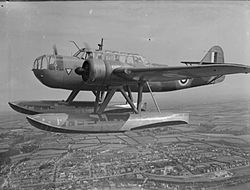No. 320 Squadron RAF
| No. 320 (Netherlands) Squadron RAF | |
|---|---|

|
|
| Active | 1 June 1940 – 2 August 1945 |
| Country |
|
| Allegiance |
|
| Branch |
|
| Type | Inactive |
| Part of |
RAF Coastal Command RAF Bomber Command RAF Second Tactical Air Force |
| Motto(s) |
Latin: Animo libre dirigimur ("We are guided by the mind of liberty") Dutch: ("Wij worden geleid door een vrije geest") |
| Insignia | |
| Squadron Badge | In front of a fountain an orange tree fracted and eradicatedThe orange tree refers to the squadron's connection with the Netherlands and the fountain to its operations over the sea |
| Squadron Codes |
SP (allocated June 1939 – Sep 1939) TD (Jun 1940 – Oct 1940) NO (Oct 1940 – Aug 1945) |
No. 320 (Netherlands) Squadron RAF was a unit of the Royal Air Force during World War II formed from the personnel of the Royal Netherlands Naval Air Service.
Formed on 1 June 1940 at Pembroke Dock, after flying from the Netherlands in eight Fokker T.VIIIW twin-engined patrol seaplanes, as part of Coastal Command. The squadron flew coastal and anti-submarine patrols in the Fokkers until they became unserviceable due to lack of spares and were re-equipped with Ansons in August 1940 and supplemented in October with Hudsons. Due to insufficient personnel, the squadron absorbed No. 321 (Netherlands) Squadron on 18 January 1941.
The squadron moved to RAF Leuchars on 1 October 1941, re-equipped with Hudson IIIs, flying patrols and anti-shipping attacks in the North Sea. Detachments were located at RAF Silloth and RAF Carew Cheriton until 24 April 1942 when the squadron moved to RAF Bircham Newton. The squadron was reassigned to Bomber Command and loaned to No.2 Group on 15 March 1943. The squadron was re-equipped with Mitchells during spring 1943 and moved to RAF Methwold.
On 30 March 1943, the squadron moved to RAF Attlebridge, then was reassigned to Second Tactical Air Force on 1 June with the squadron attacking enemy communications targets and airfields. The squadron relocated to RAF Lasham on 30 August and to RAF Dunsfold on 18 February 1944. From these airfields the squadron participated in many "Ramrod" and "Noball" operations and bombing attacks on construction works, railway yards, fuel dumps and V-1 sites in the North of France, in advance of D-Day.
...
Wikipedia
